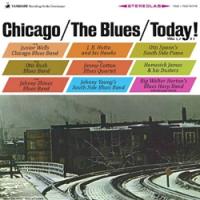Chicago "Field Recordings" Continue to Excite the Senses
This set produced by blues historian Samuel Charters and first issued in 1966 is sort of a "field recording" except that the recordings took place at RCA's old lakeside studios, December of 1965. It's a "field recording" in the sense that Charters' goal was to document what was happening in the small clubs dotting the South side of Chicago.
Charters wasn't interested in producing full albums by any of the artists. A selection of tunes would do, that would add up to a vital documentation of what was then happening in Chicago, minus, of course, some of the biggest names in Chicago blues like Muddy Waters, who was signed to Chess.
But that was okay too because Charters was more interested in what the younger, less well-known musicians were doing—not that even the most popular ones like Muddy Waters were known at the time to white kids unless they lived in the U.K.
That was just a sad fact of life: thanks to UK enthusiasts like Alexis Korner the blues was better known among young white musicians there than in America. Korner introduced the music to Brian Jones and Jimmy Page, among others.
The Stones probably did more to introduce this music to the white American audience than any individual or group, but so did the Chicago-based Butterfield Blues Band made up of young white musicians and a black rhythm section, veterans of Howlin' Wolf's band.
This three record set, originally issued as three separate albums, is the result of Charters' pioneering work that winter and it created a surprise sensation as much because of when it was released as what was in the grooves.
The blues was breaking big in America and none of these groups were well known outside of Chicago back then except to a few serious fans. Given who's here, that's hard to believe today, but it's true.
The Junior Wells Chicago Blues Band, The Otis Rush Band, J.B. Hutto and his Hawks, Otis Spann's South Side Piano, Walter Horton, "Memphis" Charlie Musselwhite and the others were mostly young unknowns when they signed with Charters and Vanguard for very little money, but once these records were released all of that changed. < Jimi Hendrix owned the set as did, of course, thousands of others who treasured the raw power and purity of purpose of these mostly club musicians, though some like Willie Dixon and some of the others were better known and were veterans of many recording sessions
The recordings are simple, direct and in some ways primitive. The "stereo" is like that of the early Beatles albums. Charters recorded everything live, putting the vocals on one track and everything else on the other so that in the final mix down to mono a good blend could be achieved. But, because of a great deal of leakage among the microphones and a careful kiss of reverb, there's little of the hard left/right found on those early Beatles records.
Whatever is less than realistic about the stereo spread is more than made up for by the utter transparency and directness of the recorded sound. There's next to nothing between the microphones and the tape recorder and that results in an open window onto the live performance in the room.
This is the root of all that is rock'n'roll and it has an unbeatable power, purity and purpose not to be missed.
The 3 LP set costs $100 but it's well-mastered from tape copies by Ray Staff at Air Mastering, beautifully pressed at Pallas and the package includes a nicely presented 25 page full-sized booklet with annotation and photos all in a cloth-bound box.
Highly recommended!



